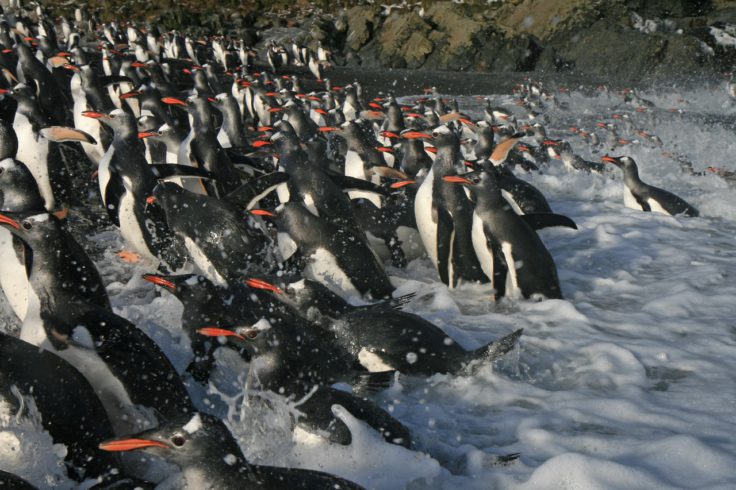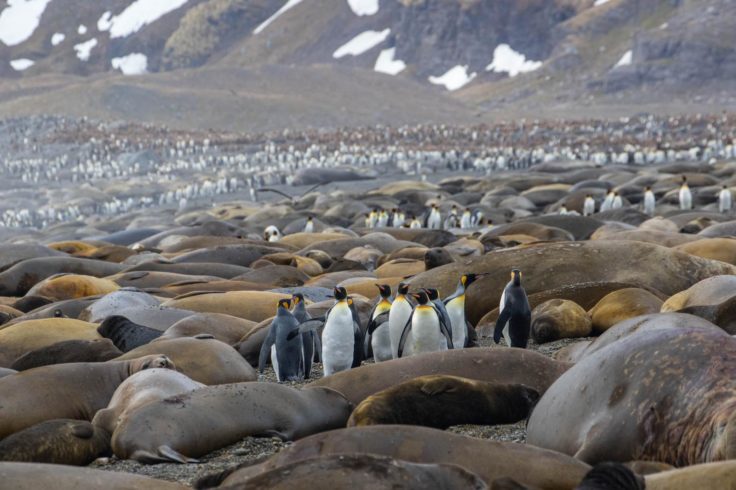SOUTH GEORGIA. Update, March 2024 –
Penguins on the sub-Antarctic Islands of South Georgia have tested positive for Avian flu. This is the first time the virus has been detected in gentoo and king penguin populations on the islands.
Several individual penguins have tested positive for High Pathogenicity Avian Influenza (HPAI), including five king penguins from Will point, on the north east coast of the islands, and five gentoo penguins from nearby Bird Island.
South Georgia is a haven for wildlife and research programmes are in place to study the penguins, seals and seabirds that live there. HPAI was first detected in brown skuas at Bird Island, South Georgia in October 2023. In early 2024, cases were confirmed in populations of elephant seals and fur seals. Antarctic terns and wandering albatross later tested positive. However, effects of infection appear to remain highly localised.

The team at British Antarctic Survey (BAS), at Cambridge and on the islands at both King Edward Point and Bird Island, are working closely in collaboration with the Government of South Georgia and South Sandwich Islands (GSGSSI), who govern the territory.
Recent samples were collected from the islands and were tested at the International Reference Laboratory for Avian Influenza at the Animal & Plant Health Agency (APHA) laboratories in Weybridge, UK.
There are two British research stations on South Georgia: King Edward Point and Bird Island. As a result of the confirmed cases of HPAI, fieldwork involving close contact with impacted species has been suspended. BAS staff continue to follow strict GSGSSI biosecurity measures adopted this season of enhanced cleaning of clothing and field equipment when moving between sites with high densities of wildlife, as well as remaining vigilant for signs of disease.
Dr Norman Ratcliffe is a bird ecologist at BAS and has worked on penguins and seabirds on South Georgia. He says:
“The highly pathogenic form of bird flu has been present on South Georgia since October and we are surprised penguins have only just become infected, given their high nesting densities and proximity to other species that have been affected. The mortality this has caused for gentoo penguins has been localised and brief but we will continue to monitor the spread and impacts of the disease. Macaroni Penguins will remain vulnerable as they gather in large concentrations to moult but subsequently will disperse to sea where transmission will be low. Gentoo and king penguins, however, continue to form communal roosts or to breed, respectively, throughout the winter and so may remain at risk.”
Elements of the wider science programme at King Edward Point and Bird Island continue under caution, including long-term monitoring of wandering albatross, black-browed albatross, grey-headed albatross, northern and southern giant petrels, gentoo penguins and macaroni penguins.

South Georgia has some of the most closely monitored seabird colonies in the world, equipping scientists and conservationists with indicators of change for species.
BAS and GSGSSI are working closely with DEFRA’s Animal Plant Health Agency (APHA) to monitor and control the spread of the disease and to understand the impact on the region’s wildlife.
Professor Ash Banyard, APHA’s Head of influenza and avian virology said:
“South Georgia is home to some of our most unique and special wildlife and is of great importance to international biodiversity, so it is sad to witness the effects of avian influenza on these populations. However, these cases remain fairly isolated, and we are not seeing a rapid spread through penguin colonies.
“As a world leading International Reference Laboratory, our Weybridge site will continue to work with the Government of South Georgia and South Sandwich Islands, the Falkland Islands and the British Antarctic Survey to monitor the impact of the wildlife on South Georgia, and the potential spread to other areas.”
Although detections of H5N1 in mammalian species continue genetic sequence data analysed to date has indicated that there is no increased risk to human health and the risk of human infection with H5N1 remains very low.
